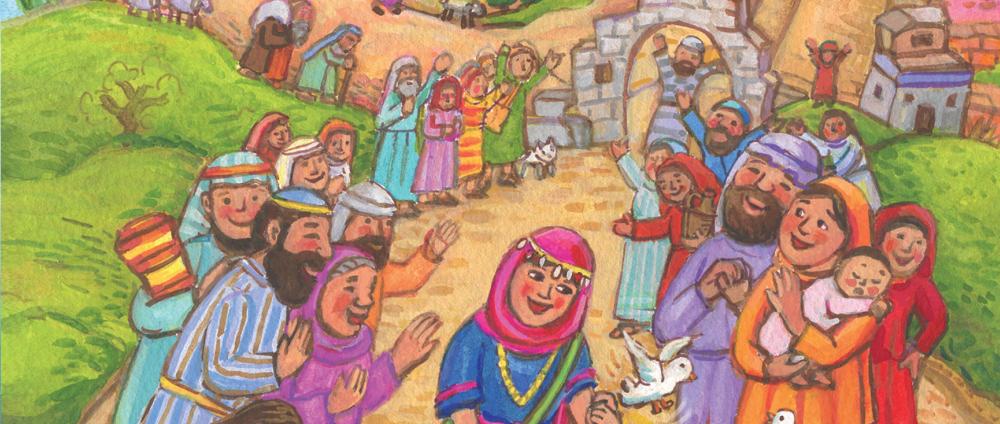
Easter: Jesus Is Alive!
This special session is intended to be inserted into your schedule near Easter Sunday. If you’re just starting this unit, you’ll want to begin with session 1.
- Imagine how the women felt when Jesus died and became alive again.
- Express joy that Jesus is alive and will never leave us.
- Share with others the amazing miracle of Jesus' resurrection.
Leader Reflection
Easter is Christianity's big day! Easter means that Jesus won, that God won, and that we will finally win. It's the centerpiece of God's saving work.
I'm not sure we always get this. Ask most Christians what salvation is about and they will say something like this: "Jesus died for our sins." That's true. But if he died for our sins, and that's it, we are, as Paul says in 1 Corinthians 15, "to be pitied more than all others." Jesus' resurrection, not just his death, means that sin and death are now defeated. Jesus faced it down on the cross, and God vindicated his sacrifice by raising him from the dead.
For all its importance, it's striking that nowhere in the Bible do we find an actual eyewitness account of the resurrection itself. We only read about the results and the reactions. No human eyes saw the actual occurrence, but there are eyewitnesses who saw the empty grave and saw Jesus himself, touched him, ate with him, and heard him speak.
All four gospels tell a similar story. The women went to the tomb early on Sunday morning and found the stone rolled away. An angel announced that "Jesus, who was crucified" is risen. Later that day, Jesus appeared to all of them together. That's the bare bones story.
In Matthew, the Easter story is one of the shortest in the four gospels, but it's also the most spectacular. The other gospels describe quiet garden scenes interrupted by angel visits, while the women and other disciples move back and forth from the empty tomb to the upper room. Matthew zeroes in on the Bang! Pow! aspect of this tremendous event. It's all about earthquakes and scary bright white figures, and guards falling down like dead men. Clearly, Matthew wants us to see that this is the greatest event in the whole history of the world, an earth-shattering moment.
As in the other gospels, the women are the first ones at the tomb, and they are given instructions to "go quickly and tell his disciples." It's remarkable that these women are chosen to be the original eyewitnesses to this central event in human history even though at that time the testimony of women was not accepted in Jewish courts.
Still afraid (who wouldn't be!) but joyful, the women hurry to obey the angel's instructions. But as they are running there, the Lord himself meets them. "Greetings," Jesus says. In Greek the word has two meanings, a greeting that is the same word as "rejoice!" What a wonderful combination!
"They clasped his feet and worshiped him." Here Matthew gives us a somewhat different picture of the reception they gave the risen Lord. In Mark and Luke they are fearful, doubtful, wondering. But ultimately, as Matthew tells us, they became the first to do what we in the church have done through the centuries—they worshiped and adored the risen Lord.
Again, the message is "go and tell," and that has remained the message for all time. Later in this chapter, just before his ascension, Jesus elaborates what he means with what we now call the Great Commission. "Therefore go and make disciples of all nations, baptizing them in the name of the Father and of the Son and of the Holy Spirit, and teaching them to obey everything I have commanded you. And surely I am with you always, to the very end of the age." As a teacher, you are now carrying out that commission as you excitedly tell the story that makes all the difference to your children.
Why are the gospel accounts slightly different from each other?
Why were there no eyewitness to the actual event of the resurrection?
What does the resurrection mean to you personally?
Of all the lessons, this is the one in which it’s so important to convey your own excitement and joy about the meaning and the power of this event for you.
Urge your children also to “go and tell.”
Steps
Before children arrive today, create three distinct and different storytelling areas in your room that depict the events of Holy Week. Possible suggestions include:

Get Unlimited Access!
Sign up for DWELL Digital to unlock all online leader resources, printable pages and session plans.
Call 800-333-8300 or Request Access
Already a subscriber? Log In
Learn About DWELL
DWELL helps kids find their place in God's Big Story. Learn more about this popular and trusted children’s ministry curriculum.
